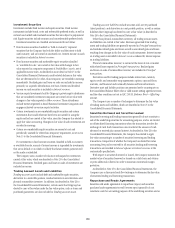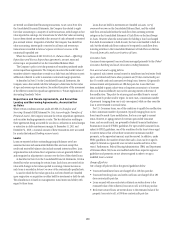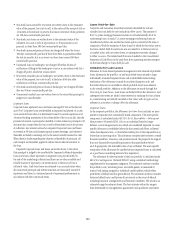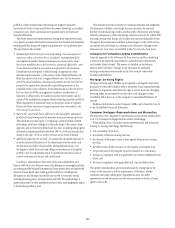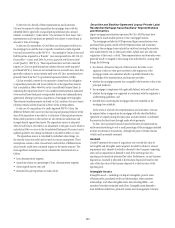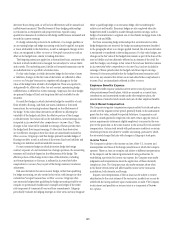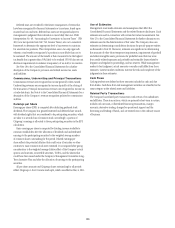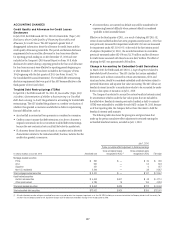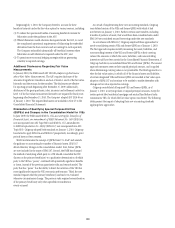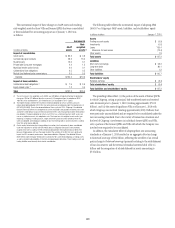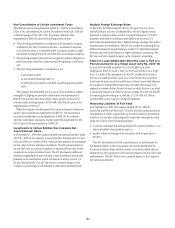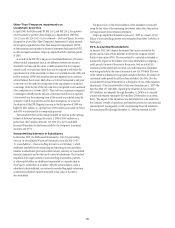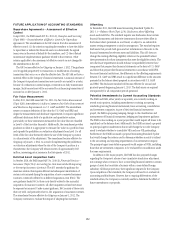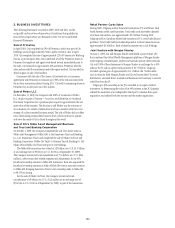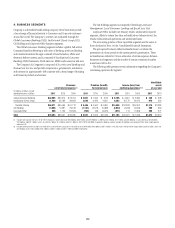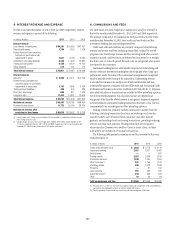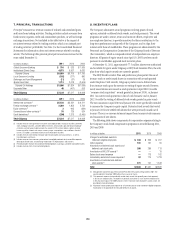Citibank 2011 Annual Report Download - page 170
Download and view the complete annual report
Please find page 170 of the 2011 Citibank annual report below. You can navigate through the pages in the report by either clicking on the pages listed below, or by using the keyword search tool below to find specific information within the annual report.148
Beginning July 1, 2010, the Company elected to account for these
beneficial interests under the fair value option for various reasons, including:
(1) To reduce the operational burden of assessing beneficial interests for
bifurcation under the guidance in the ASU;
(2) Where bifurcation would otherwise be required under the ASU, to avoid
the complicated operational requirements of bifurcating the embedded
derivatives from the host contracts and accounting for each separately.
The Company reclassified substantially all beneficial interests where
bifurcation would otherwise be required under the ASU; and
(3) To permit more economic hedging strategies without generating
volatility in reported earnings.
Additional Disclosures Regarding Fair Value
Measurements
In January 2010, the FASB issued ASU 2010-06, Improving Disclosures
about Fair Value Measurements. The ASU requires disclosure of the
amounts of significant transfers in and out of Levels 1 and 2 of the fair value
hierarchy and the reasons for the transfers. The disclosures are effective
for reporting periods beginning after December 15, 2009. Additionally,
disclosures of the gross purchases, sales, issuances and settlements activity in
Level 3 of the fair value measurement hierarchy are required for fiscal years
beginning after December 15, 2010. The Company adopted ASU 2010-06 as
of January 1, 2010. The required disclosures are included in Note 25 to the
Consolidated Financial Statements.
Elimination of Qualifying Special Purpose Entities
(QSPEs) and Changes in the Consolidation Model for VIEs
In June 2009, the FASB issued SFAS No. 166, Accounting for Transfers of
Financial Assets, an amendment of FASB Statement No. 140 (SFAS 166,
now incorporated into ASC Topic 860) and SFAS No. 167, Amendments
to FASB Interpretation No. 46(R) (SFAS 167, now incorporated into ASC
Topic 810). Citigroup adopted both standards on January 1, 2010. Citigroup
has elected to apply SFAS 166 and SFAS 167 prospectively. Accordingly, prior
periods have not been restated.
SFAS 166 eliminates the concept of QSPEs from U.S. GAAP and amends
the guidance on accounting for transfers of financial assets. SFAS 167
details three key changes to the consolidation model. First, former QSPEs
are now included in the scope of SFAS 167. Second, the FASB has changed
the method of analyzing which party to a VIE should consolidate the VIE
(known as the primary beneficiary) to a qualitative determination of which
party to the VIE has “power,” combined with potentially significant benefits
or losses, instead of the previous quantitative risks and rewards model. The
party that has “power” has the ability to direct the activities of the VIE that
most significantly impact the VIE’s economic performance. Third, the new
standard requires that the primary beneficiary analysis be re-evaluated
whenever circumstances change. The previous rules required reconsideration
of the primary beneficiary only when specified reconsideration
events occurred.
As a result of implementing these new accounting standards, Citigroup
consolidated certain of the VIEs and former QSPEs with which it had
involvement on January 1, 2010. Further, certain asset transfers, including
transfers of portions of assets, that would have been considered sales under
SFAS 140 are considered secured borrowings under the new standards.
In accordance with SFAS 167, Citigroup employed three approaches for
newly consolidating certain VIEs and former QSPEs as of January 1, 2010.
The first approach requires initially measuring the assets, liabilities, and
noncontrolling interests of the VIEs and former QSPEs at their carrying
values (the amounts at which the assets, liabilities, and noncontrolling
interests would have been carried in the Consolidated Financial Statements, if
Citigroup had always consolidated these VIEs and former QSPEs). The second
approach measures assets at their unpaid principal amount, and is applied
when determining carrying values is not practicable. The third approach is to
elect the fair value option, in which all of the financial assets and liabilities
of certain designated VIEs and former QSPEs are recorded at fair value upon
adoption of SFAS 167 and continue to be marked to market thereafter, with
changes in fair value reported in earnings.
Citigroup consolidated all required VIEs and former QSPEs, as of
January 1, 2010, at carrying values or unpaid principal amounts, except for
certain private label residential mortgage and mutual fund deferred sales
commissions VIEs, for which the fair value option was elected. The following
tables present the impact of adopting these new accounting standards
applying these approaches.


